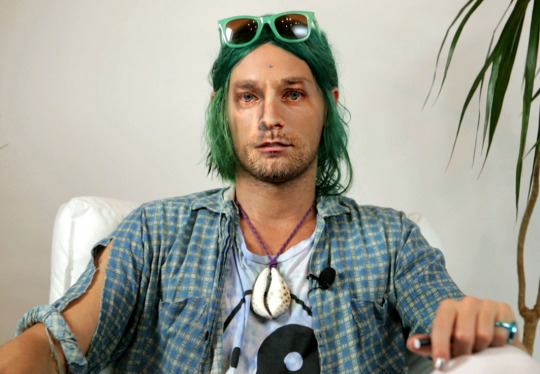
Josh Kline, Forever 27, 2013, Video still HD video, color, sound, 14:39 min. Image courtesy the artist.
Stephanie LaCava on John Barth, Authorship, and “Giles” at Gagosian Athens
Here I am, waiting for an update on Steven Soderbergh’s TV series adaptation of John Barth’s 1960 book, The Sot-Weed Factor. Confirmed again late last year, the project doesn’t seem to have moved forward, unsurprising considering Hollywood’s fear about the commercial viability of such a story. This is itself important considering the Barth’s own complicated vision of creative work, virtue and the establishment, whatever form it may take.
Still, the moment is ripe for that trickster Barth to rear his head after years of having fallen out of fashion. So, perhaps unsurprisingly, another of his works has popped up as a clever touchstone in a contemporary context as the crux of a new Gagosian gallery exhibition, which opened a few weeks ago in its Athens’ location.
Through the end of November, “Giles,” a group show curated around Barth’s metafictional novel Giles-Goat Boy will be on display.
“I am a romantic leftover that enjoys reading and feels comfortable in literature,” says independent curator Artemis Baltoyanni about the genesis of the show. When Baltoyanni reread the Giles-Goat Boy, she was taken with the text’s approach to redefining and exploring the idea of failure, both as an artist and human being.
At around eight hundred pages, the 1966 cult-classic is a multi-layered narrative surrounding the life and times of Billy Bockfuss (our George Giles, goat boy) on his hero’s journey to become a great spiritual leader known as the Grand Tutor. A metafictional work, the start of the book features a disclaimer about the story’s origin, claiming it is not from the author’s imagination, but rather from another man who then shoulders the origin as technologic—from the machinations of a computer. All this sounding suspiciously similar to academic discussions of speculative realism and aesthetics, and the current landscape of the artist’s identity amid new media.
In her original notes on the project, Baltoyanni writes. “In Goat-Boy we find an alter ego of the author, one that captures the rite of passage from early naif writer to maturity—perhaps even later recognition and renown.” For her, the cohesion exists in an awareness of one’s own artificiality, or the artificiality of pursuing an abstracted identity as artist or author. “I have never done a show of this size,“ she wrote me, “and to be honest it is a bit like opening a therapist’s office (in the sense of one that studies, not one that heals).”
As part of the preface to Giles-Goat Boy is a argument among fictitious editors, Barth himself...
You have reached your article limit
Sign up for a digital subscription and continue reading all new issues, plus our entire archives, for just $1.50/month.
Already a subscriber? Sign in




